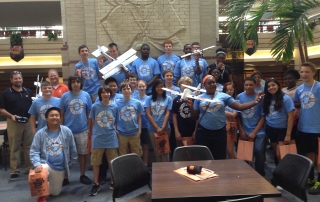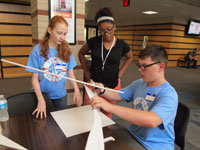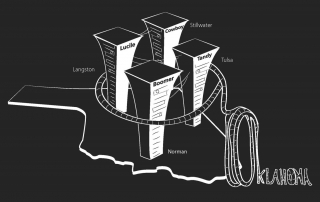Tech-oriented workers in high demand, study shows
In the post-recession economy, jobs that require skills in science, technology, engineering and mathematics are in high demand compared to other jobs, according to a report released Tuesday by the Metropolitan Policy Program at the Brookings Institution.
Many metros, including the Tulsa area, are having to advertise for longer periods to fill these positions, which are also referred to as STEM jobs, because of the difficulty in finding qualified workers.
In its first metro analysis of job openings and hiring difficulty, Brookings finds that companies across the country are facing a growing challenge to fill STEM positions, despite high salary offers, according to the report.
The supply of STEM workers, which includes blue collar, craft and professional occupations, is not keeping up with demand.
For its report — “Still Searching: Job Vacancies and STEM Skills” — Brookings used a database produced by Burning Glass, a leader in labor market analytics. It looked at job vacancies advertised in every U.S. metro area on company websites in 2013, which included a total of 3.3 million advertisements across 52,000 companies.
Brookings, a Washington, D.C.-based think tank, found that advertisements for STEM jobs run more than twice as long than those for all other types of jobs. Those that require a doctorate or professional degree are advertised an average of 50 days, compared to 33 days for all other vacancies, the report states.
According to Brookings, the Tulsa metro had 4,051 ads for job openings in the 2013 first quarter, of which 37 percent required STEM skills. The report said 25 percent of those ads required STEM skills and at least a bachelor’s degree.
The study also found that some STEM jobs that don’t require a bachelor’s degree are harder to fill than some professional non-STEM jobs that do require a bachelor’s degree, said Jonathan Rothwell, associate fellow at the […]
Tulsa Regional STEM Alliance Update for June
Dear Colleagues,
The Tulsa Regional STEM Alliance had a busy June filled with summer camps, visits with business and community partners and ending with a great article in the Tulsa World, Tech-oriented workers in high demand, study shows. Below are some key updates from the month.
Innovation Rooms Updates
IR TRSA STEM Mentoring Logistics
Working to have some mentoring pilot programs for the fall with Union Public Schools.
Met with Victoria Bartlett to learn more about the Mayor’s Mentoring to the Max program as well as learning more about past and present mentoring programs.
Multiple meetings on starting a pilot Engineering Alliance for the Arts (EAA) in Tulsa:
Meeting with Wallace Engineering
Teleconference with EAA leaders out of San Francisco
Meetings with Union Public Schools and Tulsa Public Schools to find out about their past and present STEM Mentoring programs.
Meeting with the Tulsa Regional Chamber to investigate future STEM Mentorship partnerships.
Explored future STEM Mentorship partnership with Tulsa Tech leaders.
General Updates
Met with Kathy Taylor and Monroe Nichols with Impact!Tulsa to explore areas of collaboration between TRSA and Impact!Tulsa
Discussed data metrics and that possibility of organizing a data council
Teleconference with US2020
Overview of Judges’ feedback from Round 2 of the City Competition
Covered planning and implementation of TRSA so far.
TRSA key strategies to accomplish goals
Preview of Convening 1 in Boston on 7/8/14–7/9/14
6/30/14 – Conducted interview with Tulsa World on the role of STEM jobs in Tulsa’s economy
New Collaborations
Presented TRSA Business Plan, Advisory Council and Mentorship Initiative to Matrix , Williams, APSCO and NORDAM
Enthusiastic about participating on the Advisory Council
Smartsheets
Please take a chance to look at our growing list of TRSA Smartsheets. If you’d like have access to the Smartsheets, please contact Annie Tyndall, OII / TRSA Communications & Marketing Coordinator at [email protected].
Tulsa STEM Activities Sheet
TRSA Summer STEM Activities
TRSA STEM Employment Opportunities
TRSA Spring Break STEM Activities
TRSA Speakers’ Bureau
TRSA Communication IR
STEM Outreach Evaluations
STEM Mentoring […]
Budding Engineers
Budding engineers take flight at OSU-Tulsa summer camp
Madison Maier is precise with her measurements. She knows a few extra centimeters of foam board could be the difference between a soaring model drone and a pile of broken materials.
“I like measuring and trying different designs to make the best drone,” said Maier, a freshman at Glenpool High School. “It’s pretty cool that you can take regular foam boards and turn them into something that can fly.”
Though she’s only in her first year of high school, Maier is already considering a career in engineering. That interest brought her to Oklahoma State University-Tulsa on Friday to build a model unmanned aerial vehicle, or what’s more commonly known as a drone.
The project was part of the Tulsa Alliance for Engineering’s annual summer camp for middle and high school students. OSU-Tulsa partnered with Wallace Engineering for the event, which gives students like Maier the opportunity to learn more about the different fields of engineering.
The camp included instruction from Dr. James Kidd, OSU clinical associate professor of mechanical and aerospace engineering, on aerospace mechanics and a lesson on how to build a model drone. Students applied the knowledge they gained from Kidd to build their drones.
Maier was placed with a team of eight other students to design, construct and test a model drone using foam board, glue and an electronic motor.
“Each member brought their own ideas about design and construction and they had to come together as a team to find the best solution,” said Ronald Knight, OSU-Tulsa academic coordinator for the College of Engineering, Architecture and Technology. “In addition to applying engineering concepts, the activity teaches them important lessons about problem solving and teamwork.”
The project challenged A.J. Pace, a freshman at Broken Arrow High School, because of the number of people on his team.
“I […]
TSC to Utilize Spectra Logic’s nTier Verde
BOULDER, Colo., June 10 – Spectra Logic announced today that the Tandy Supercomputing Center (TSC) selected a Spectra nTier Verde disk-based file storage system to increase its workflow performance and shorten calculation rates from days to minutes. Spectra’s solution enabled TSC to seamlessly boost data access speeds for multiple users by moving lower-priority, lower-performance operations from a primary storage tier to an affordable, flexible, high-capacity file storage system.
“In an unpredictable HPC environment with multiple users from a variety of institutions and disciplines, storage has been one of our biggest IT challenges. We needed the tools to react to the evolving needs of our users, quickly and flexibly,” said George Louthan, director, Tandy Supercomputing Center. “The nTier Verde/T50e combination is ideally suited to our shared environment and supports our data staging, backup and archive needs more flexibly and affordably than the market alternatives.”
Recently implemented, the Spectra storage solution is already saving both time and lives. A post-doctoral research associate at OSU Center for Health Sciences used the supercomputer to refine a software technology developed to predict the onset of heart attacks. Computational time was reduced by more than 95 percent. Computations that previously took 20 to 30 minutes were finished in less than a minute, and this data is securely stored within TSC’s Spectra Logic storage solution.
TSC’s new storage solution includes a Spectra T50e tape library along with the nTier Verde system to increase its research and engineering workflow performance, caching backups and providing nearline storage for its community’s data sets. TSC manages approximately 30 TB of escalating data, consisting primarily of scientific data sets for research projects, for a community of users that includes four higher education institutions and multiple private sector users. The nTier stages TSC’s backup data using AMANDA backup software before it is sent to the […]
Spectra and the Tandy Supercomputer Shorten Calculation Rates
CASE STUDY: Spectra and the Tandy Supercomputer shorten calculation rates from days to minutes, saving time and lives.
America’s First “Community” Supercomputer
TSC’s business model is unique because it creates a community of users, sharing the costs of infrastructure and support, making this resource available to parties who couldn’t otherwise afford it. Located in the Data Center at One Technology Center (Tulsa City Hall), TSC is committed to continuously provide their users with modern high performance technology by regularly updating the supercomputer with state of the art technology. This allows TSC to seamlessly add nodes as its membership base increases.
The Challenge: Affordable, Transparent File Storage
The Oklahoma Innovation Institute launched its community supercomputer project in 2013. TSC currently manages approximately 30 TB of data for its users, primarily scientific data sets for research projects. TSC has a large, high-performance Panasas object storage system and acts as a global storage pool for multi-user access. The IT team decided to house some data on-site at their Tulsa datacenter, and sought a reliable, scalable storage solution to archive information being accessed by multiple users at any given time.
TSC needed to provide an alternative from their primary Panasas NAS for medium-term archive and lower-speed workflows with many metadata operations. The envisioned solution would ease the load on the primary storage to increase the overall performance of demanding research and engineering workflows. TSC wanted to offer transparent file storage access that was invisible to the individual users accessing the data frequently.
Spectra Logic
June 10, 2014
Link to Case Study
Tulsa Regional STEM Alliance Update for May
Dear Colleagues,
We are thrilled by the impact of the Tulsa Regional STEM Alliance and its strong partners in the first five months since the TRSA launch! We wanted to update you on the many incredible things that are happening in the Tulsa region because of TRSA!
Innovation Rooms Updates
STEM Mentorship Logistics IR – Gaining momentum thanks to efforts on several fronts:
Two former Samson engineers are leading the way in creating a detailed blueprint for effectively scaling STEM a sustainable, high quality, high impact mentorship in fall 2014. The team is meeting weekly to design this bold new initiative.
Met with area business and academic leaders are working on plan for creating year round STEM mentorship through building quadcopters!
General Updates
Business Plan for TRSA – Business plan has been revised after meeting with area philanthropic groups. Now preparing to get input from local industry leaders and then begin fundraising for staffing of TRSA.
TRSA Presentations – TRSA presented STEM as a Bridge to Reconciliation at the John Hope Franklin Center for Reconciliation Symposium. Several participants are interested in working further with TRSA to build bridges of hope and opportunity through STEM.
New Collaborations
Discovery – As a result of being a US2020 finalist, TRSA was able to send two team members to Washington DC for a White House STEM reception and awards ceremony. They also had the opportunity to participate in a day long strategy session with senior executives at Discovery headquarters in Silver Springs, MD.
SmartsheetsPlease avail yourselves of the growing STEM related data bank contained in the following smartsheets:
STEM Activities
Evaluation of STEM Activities
Speakers’ Bureau
Summer STEM Activities
STEM Mentoring
Communication IR
Logistics IR
Spring Break/Summer STEM Activities IR
Curriculum IR
STEM Employment Opportunities
Programming Notes
TRSA hosted a Cardboard & Duct Tape Boat regatta for over 100 students at Miller Swim School. The various competitions were judged by engineers from US Army Corps of Engineers
TRSA […]
TRSA Named a Beneficiary for Tulsa Charity Flight Night
The Tulsa Charity Flight Night will be on September 18, 2014. This year the Tulsa Regional STEM Alliance will be a beneficiary, along with the Fab Lab Tulsa.
The Siegfried family’s long-running “Fight Night” tradition is getting a major shakeup, one that may fit the clan’s aviation leanings better. In September, the annual “Fight Night” will become “Flight Night,” with an ‘L,’ and is moving from the ring to the air. Instead of prizefighting, the Sept. 18 fundraising and flight-themed event will feature an air show, entertainment and a live auction.
For 21 years Fight Night brought in the biggest names in the pugilism, such as Muhammad Ali, Joe Frazier and Evander Holyfield. But the family wants to put more emphasis on education, and their NORDAM company’s emphasis on supporting so-called STEM areas — science, technology, engineering and math.
“This collaboration will be a game-changer in STEM education in the Tulsa region,” said Bailey J. Siegfried., vice president of global marketing at NORDAM in a statement. “The funds generated from Tulsa Charity Flight Night will inspire creativity, spark excitement and harness the inspiration, resources and experience of STEM stakeholder, ultimately broadening horizons for children across northeastern Oklahoma.”
With funds raised from the event, the family hopes to fund a one-day STEM event in Tulsa for students, a Quadcopter challenge where students compete against each other designing flying machines, as well as a mobile “fab lab” to engage students in emerging technologies.
“Trained specialists in STEM disciplines are critical to many, if not all, industries in our city, state and nation to properly compete globally and create technology to propel us into the future,” said NORDAM CEO Meredith Siegfried.
Along with NORDAM, the Muscogee Creek Nation and Asphalt Fuel Supply are title sponsors of the event. The Flight Night group is still working on getting clearance […]
National Science Foundation Award Grant
The National Science Foundation awarded a grant in September of 2013 to the OneOklahoma Friction Free Network (OFFN) to deploy a high speed research network between the supercomputing centers in the state of Oklahoma.
The OneOklahoma Friction Free Network (OFFN) is a collaboration among four Oklahoma institutions that have significant High Performance Computing resources available for academic research: the University of Oklahoma, Oklahoma State University, the Tandy Supercomputing Center of the Oklahoma Innovation Institute, and Langston University, Oklahoma’s only Historically Black University, along with OneNet, Oklahoma’s education, research and government information and telecommunications network.
Triggered by research needs in high energy physics, numerical weather prediction, bioinformatics and weather radar, but available for researchers across all Science, Technology, Engineering and Mathematics (STEM) disciplines statewide, OFFN serves as a crucial component of the OneOklahoma Cyberinfrastructure Initiative (OneOCII), which provides resources and services to researchers and educators across the state, and which has so far served almost 100 institutions and organizations, approximately half of them academic.
For more information on the grant, please visit the National Science Foundation Website.
Oklahoma Now
Video by the Oklahoma Department of Commerce.
“Oklahoma has transformed the heartland into a global crossroads. Our businesses are booming and we’re a leader in everything from unconventional energy to unmanned aerial vehicles.”
Watch OKNOW on Vimeo.








